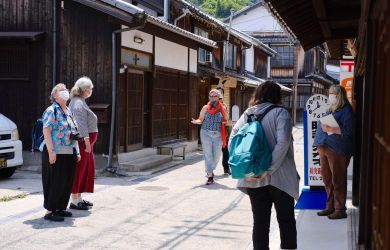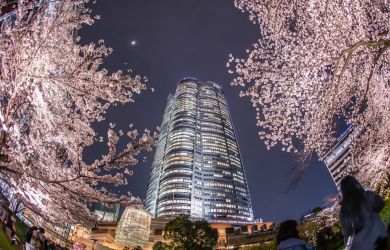
Originally published on metropolis.co.jp on January 2010

Left to right:
Hollow Dogu, Chobonaino site, Hakodate-shi, Hokkaido, Late Jomon (2000-1000BC)
Hakodate City Board of Education
Dogu with Heart-Shaped Face, Gohara, Higashi Agatsuma-machi, Gunma, Late Jomon (2000-1000 BC)
Private collection
Jomon Venus, Tanabatake site, Chino-shi, Nagano, Middle Jomon (3000-2000BC)
Chino City Board of Education
Standing Dogu, Nishinomae site, Funagata-machi, Yamagata, Middle Jomon (3000-2000BC)
Yamagata Prefectural Board of Education
National identity is an interesting phenomenon. It not only lays claim to portions of the Earth’s crust, but can also be extended retrospectively over periods of time as well, as demonstrated by “The Power of Dogu” at the Tokyo National Museum.
Based on a show held at the British Museum last year, this exhibition is touted as an attempt to “deepen understanding of Japan’s history and culture.” In fact, what it offers is an enigmatic glimpse of several cultures that were not Japanese and which all predate written history.
The show presents 67 items, mainly small, clay humanoid figurines called dogu. These date back to the Jomon period, a catch-all archeological term used to describe the hunter-gatherer peoples and cultures that existed on the Japanese archipelago from around 14,000 BC to 400 BC, when the better-organized, agricultural Yayoi culture displaced them.
Under these terms, we have the no-doubt bloody tale of the proto-Japanese arriving in these islands and conquering and absorbing the inhabitants to create the Japanese race and its early culture. The Ainu in Hokkaido are supposed to be a remnant of some of the Jomon peoples who escaped this process.
The cultural rupture produced by what was, in archaeological terms, an extremely drastic takeover by the more populous rice-growing people is one reason why dogu are now so mysterious. After the arrival of the Yayoi, the production of the clay figures was discontinued, signifying the total eclipse of the culture that motivated their manufacture.
The exhibition reflects the resultant cultural blind spot by offering a wide array of possible but contradictory explanations, in the process showing the entrenched academic ignorance on the subject, which, in cases like this, invariably hides behind speculative theories. An additional reason for the confusion is the wide variety of forms that the little mannequins take.
Some, like the 45cm-tall Standing Dogu (3000-2000 BC), are large and well-made, but others are cursory and rudimentary, so the notion that they served as sacred figures representing the gods rests on shaky ground.
Many others, like the voluptuously curved Jomon Venus (3000-2000 BC), are unmistakably female, while some, like broad-chested Hollow Dogu (2000-1000 BC), are clearly male, so theories that they were votary offerings designed to ensure fertility and successful births can’t quite explain all the evidence either.
More recent theories that dogu may have been toys or even works of art only underline the fact that the “experts” once again can offer plenty of theories but very little truth. The fact that some figures bear a family resemblance to ET has even spawned a subset of theories that they represent visitors from outer space!
Although the true significance of the dogu will continue to remain shrouded by the mists of time and academic miasma, what can be gauged is their relevance as inspiring objects of mystery over the years. The Nobel Prize-winning novelist Yasunari Kawabata kept one on his desk, and Taro Okamoto, Japan’s most famous artist of the modern era, was deeply influenced by them. The main face of Okamoto’s giant, iconic Tower of the Sun sculpture, made for the 1970 Osaka Expo, is a dogu face, while in his cultural theories, the Jomon and Yayoi came to represent a Japanese version of the Dionysian and Apollonian dichotomy of European culture. What the sculptors of the dogu would make of such intellectualization is anybody’s guess.
The word “dogu” is similar to “gaijin” in that it is one word used to describe a multitude of things. This, in itself, is an admission of ignorance. But it is the unanswered questions surrounding the figures that continue to give these quaint-looking totems their aura of unearthly power.
The Power of Dogu. Ceramic figurines. Until Feb 21, free (MS and under)/¥400 (HS)/¥600 (univ)/¥800 (adult). 13-9 Ueno Park, Taito-ku. Tel: 03-3822-1111. Open Tue-Sun 9:30am-5pm, closed Mon. Nearest stn: Ueno. www.tnm.jp





